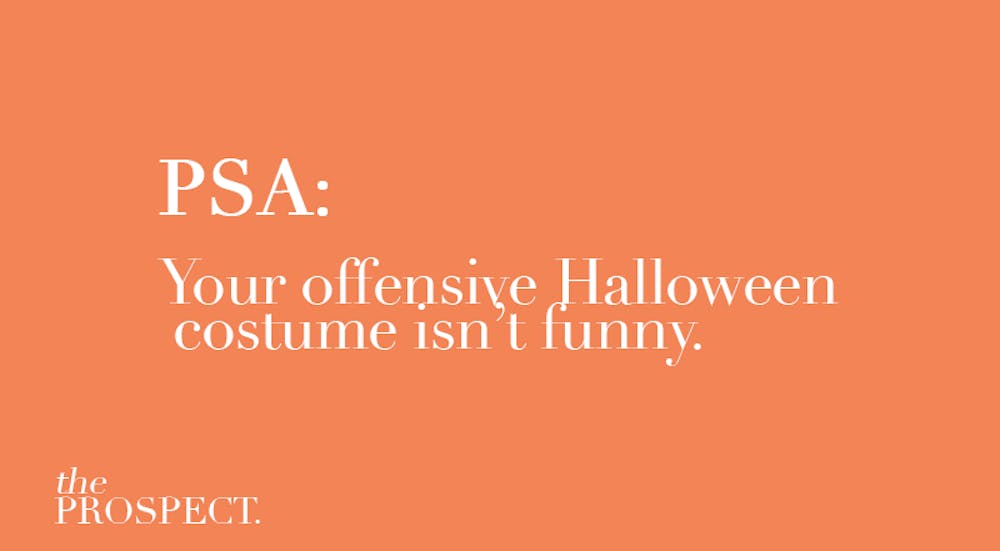For many Princeton students, one of the few bright spots of the midterms slog is planning themed Princetoween costumes, events, and decor with friends. While Princeton’s premature Halloween festivities bring together a student body emerging from many days of library hibernation, an offensive theme choice can do just the opposite. Often the University emails a cultural sensitivity reminder at this time of year, although such reminders sometimes skirt around the words “cultural appropriation.”
Princeton has a history of controversies that fit the label, and they are not limited to Princetoween celebrations. Just two years ago, The Daily Beast caught on to a campus incident with an article bluntly titled “How Racist Was Princeton’s ‘Mexican’ Party?” The party set out to cartoonize the appearance, garb, and language of an ethnic group — it isn’t surprising that such a blatant case of cultural appropriation would get national attention.
We wanted to dig into cultural appropriation beyond its most blatant and sensationalized forms and get a sense from campus leaders of how to approach the issue — both during and beyond Princetoween time.

Tylor-Maria Johnson ’19
Tylor-Maria Johnson ’19, president of Princeton’s Black Student Union, responded to a request for comment on cultural appropriation and Princetoween by passing along a statement from the Carl A. Fields Center for Equality and Cultural Understanding. Johnson wrote, “I think this message, and the caption from the pictures, needs to be sent around to students in full because it explains the topic well, and shows how students might avoid appropriating cultures.” The Fields Center’s statement, along with photo examples of appropriative costumes, was posted on Facebook on Oct. 24, 2017, and can be found at this link.

Aydan Celik ’21
Aydan Çelik ’21 and Tobi Ayeni ’21, Woke Wednesdays president and co-president, respectively, spoke to The Daily Princetonian. Woke Wednesdays’ “mission is to provide a platform — through unfiltered videos — that fosters discussion amongst college-aged students, faculty, and administration in regards to current political and social issues in our everyday lives both on and off of campus.”
Beginning with a definition of cultural appropriation raised more questions than it answered. Ayeni defined cultural appropriation as “an act that emulates the culture of another group in a manner that is ignorant to the culture and offensive.” Çelik added that cultural appropriation’s potential to offend is context-specific, remarking that the idea of appropriation doesn’t exist in Turkey, where her family is from. She relayed a story from her summer abroad on the East African island of Mauritius, where a woman who asked to put braids in Çelik’s hair did not understand why Çelik refused out of concern that she would be offensively appropriating the hairstyle. Ayeni agreed that context is important, adding that it is “natural that we see [cultural appropriation] in America more than other countries because it’s a society built on power differences.”
Parker Kushima ’19 and Keely Toledo ’21, the president and co-president of Natives at Princeton, respectively, also talked to the ‘Prince.’
Kushima found it difficult to pin down a definition of cultural appropriation, opting for “the use of culturally significant attire or presentation without knowing the significance behind it or what it’s actually used for.”
Given the inclusion of women and LGBTQ+ communities in the Fields Center’s list of groups whom we should take care not to appropriate, I asked Ayeni and Çelik whether they thought that the appropriation of queer culture fits into a definition of cultural appropriation. They were inclined to think it a much smaller issue, since anyone can feel free to respectfully experiment with gender identity and sexual orientation — the same cannot be said of race and ethnicity. In this case it is essentially about “intentions,” they said.
I asked what forms they had seen cultural appropriation take on campus, and whether they think it is specific to Princetoween. Çelik mused that it “depends on how sensitive you are” and wondered whether a celebration with togas could be considered offensive. “What do you count as white? Greeks are white but their culture is different.” She pointed out, however, that a “bunch of sombreros everywhere” is an obvious and recurring theme of cultural appropriation.


Parker Kushima ’19
Kushima asked the same question of toga nights, and remarked more generally that “certain Street events … lend themselves more” to cultural insensitivity. Kushima, who is from Hawaii, said, “The way I’ve always seen Hawaiian culture represented on the mainland has always been stereotypical and uninformed,” but that even such incidents are more “acceptable than if someone was wearing Native American garb. During Princetoween, “the more subtle things” come up. He concluded that “Princeton students are a little more informed and aware.”
We discussed whether a distinction between “cultural appropriation” and “cultural sharing” could ever apply to costumes or decor on Halloween. Ayeni was firm that on Halloween, the medium of costumes does not allow for appreciation rather than appropriation. Kushima and Toledo were less sure. Additionally, everyone noted some gray area as to whether dressing up in costumes of fictional characters of other ethnicities and races was acceptable. Toledo pointed out that such costumes can be degrading because they are sexualized — for example, “Sexy Pocahontas.” The question remains of whether dressing up as a specific individual can circumvent the danger of cartooning or simplifying a culture.

Tobi Ayeni ’21
Bringing it back to Princeton-specific problems, Ayeni differed from Kushima and Toledo on whether Princeton does enough to prevent and respond to instances of appropriation. Ayeni described the current approach as “one step removed,” sending out emails but neither supporting nor actively condemning offensive practices. Kushima, in contrast, described the emails as “effective.” Toledo focused instead on indirect and positive preventative measures that cultural groups can promote — namely, that “they’re very supportive of letting us have a platform and giving us funds to talk about Native issues...CAF is very good at letting us do stuff.” Educating through positive representation sets good “precedent,” she said. Perhaps both approaches must build off of each other — creating a more culturally aware and respectful campus by amplifying minority voices, as well as increasing direct dialogue on cultural insensitivity.
Kushima expressed confidence that in the current campus climate, peers will hold each other accountable. Ayeni and Çelik, on the other hand, expressed concerns about how to promote a positive peer dialogue on campus. Çelik cited this year’s emphasis on free speech at Princeton as a potential fuel for insensitivity. How do we promote free speech without licensing offensive speech? Ayeni added that the people “who are [willfully] coming to the table” to discuss these issues are usually already aware of them, and therefore, active dialogue may still not succeed in moving the campus culture forward.
Given these concerns around culture and dialogue among peers, I asked what they thought were the biggest misunderstandings around cultural appropriation that serve to perpetuate it. Ayeni felt that ignorance at a place like Princeton was more willful than anything else — a lack of care rather than a lack of understanding, to him, is often the problem. Kushima identified the lack of comprehension of “how someone of that culture would feel about it” as a barrier to sensitivity. The specific significance of certain traditions, garbs, and hairstyles are often not understood by others. Toledo also mentioned that people don’t always understand how cultural appropriation can extend beyond Halloween — everyday fashion, hairstyles, clothes, and jewelry can be appropriated when people don’t take the time to learn about their significance.
Ultimately, Ayeni and Çelik expressed less optimism than Kushima and Toledo about the development of the dialogue surrounding cultural appropriation. Ayeni described such dialogue as practically “nonexistent” outside of spaces such as Woke Wednesdays, while Kushima felt that any problematic instances stay “relatively tame,” with Toledo adding, “we’re pretty diverse here compared to a lot of other places.”
The more this topic is explored, the more stones appear to be left unturned. With all the ambiguity and misunderstanding still surrounding the issue of cultural appropriation, and with questions of free speech looming larger in the campus conscience, we’re left with the question of whether the occasional administrative reminder in late October is really enough.








